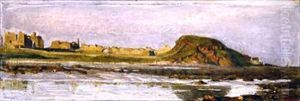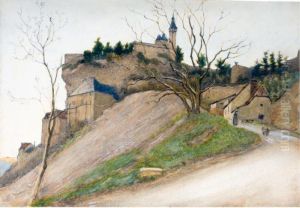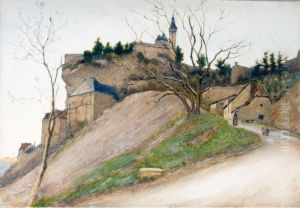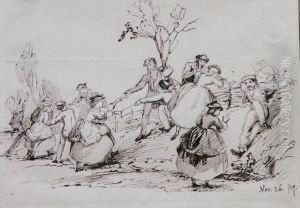Samuel Pepys Cockerell Paintings
Samuel Pepys Cockerell was a notable British architect in the late 18th and early 19th centuries. Born on April 2, 1754, in Andover, Hampshire, England, he was part of the Cockerell family, which had a significant influence on British architecture and the arts. His middle name, 'Pepys,' indicates a family connection to the renowned diarist Samuel Pepys, his great-great uncle. Samuel Pepys Cockerell was educated at Westminster School and later went on to study architecture under Sir Robert Taylor, a leading architect of the time.
In the early stages of his career, Cockerell worked on a number of country houses, which were a popular commission among the rising gentry and aristocracy in Britain. He quickly gained a reputation for his neoclassical designs, which were influenced by the prevalent tastes of the period. As his career advanced, he was entrusted with more significant projects, which included both private and public buildings. Among his notable works are Sezincote House in Gloucestershire, which he designed for his brother, Sir Charles Cockerell, and is known for its Indian-influenced architecture; and the redevelopment of the East India Company's headquarters in London.
Cockerell's work on the East India Company's headquarters, also known as East India House, showcased his adaptability and the breadth of his design capabilities. The building, located on Leadenhall Street in London, was expanded and adorned with classical features, making it one of the most impressive company headquarters in the city at the time. This project, along with others, solidified his standing as a distinguished architect.
Cockerell was also involved in public service; he was appointed as the Surveyor to the Royal Hospital Chelsea, a position he held from 1809 until his death, and was responsible for the care and maintenance of the hospital's buildings. His contributions to architecture were recognized when he became a fellow of the Royal Society.
Samuel Pepys Cockerell passed away on June 8, 1827, leaving behind a legacy of architectural works that are still admired for their elegance and historical value. His designs and buildings reflect the neoclassical style that was prevalent during his time, and his influence can be seen in the works of subsequent generations of architects. Cockerell's life and career provide a window into the architectural trends and cultural milieu of Georgian Britain.




